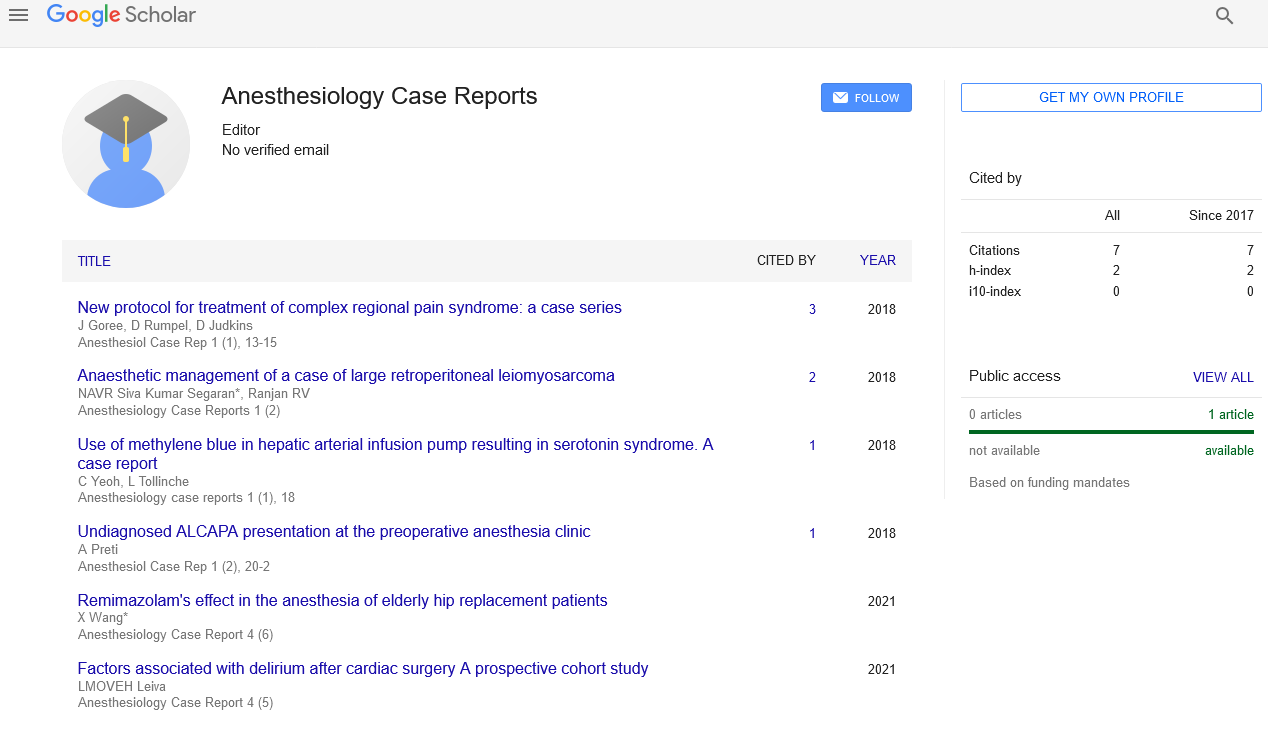Reduce and Manage Inadvertent Gastric Insufflation in Cases of Unrecognised Oesophageal Intubation
Received: 11-Jun-2023, Manuscript No. pulacr-23-6479; Editor assigned: 14-Jun-2023, Pre QC No. pulacr-23-6479 (PQ); Accepted Date: Jun 26, 2023; Reviewed: 21-Jun-2023 QC No. pulacr-23-6479 (Q); Revised: 24-Jun-2023, Manuscript No. pulacr-23-6479 (R); Published: 28-Jun-2023
Citation: Sheikh O. Reduce and manage inadvertent gastric insufflation in cases of unrecognised esophageal intubation. Anesthesiol: Case Rep. 2023; 6(3):5-6.
This open-access article is distributed under the terms of the Creative Commons Attribution Non-Commercial License (CC BY-NC) (http://creativecommons.org/licenses/by-nc/4.0/), which permits reuse, distribution and reproduction of the article, provided that the original work is properly cited and the reuse is restricted to noncommercial purposes. For commercial reuse, contact reprints@pulsus.com
Abstract
We are grateful for the consensus recommendations on preventing unrecognized esophageal intubation provided by the Project for Universal Management of Airways (PUMA) group. These give precise instructions on how to avoid, recognize, and treat esophageal intubation, which up until now was largely left to individual experience and judgement. We have a few points about the paper that we would want to address. Priority should be given to proactively excluding esophageal insertion after tracheal intubation in order to reduce gastric insufflation should the tube be inserted in the esophagus. The PUMA group advises that in order to confirm that a well-positioned tube is still in the trachea, we should look for continued good exhaled carbon dioxide waveforms (at least seven).
Key Words
Esophageal intubation; Gastric insufflation
Introduction
For initial tracheal intubation when the tube has since moved, this is sound advice. However, such a practice runs the risk of causing up to 3.5 l of gastric insufflation (assuming a volume of 500 ml each breath for at least seven breaths) before the recognition of esophageal intubation and subsequent rescue treatments. We concur with Waters et al that the clinical care of a patient benefits from the integration of clinical examination with capnography. Capnography by alone may produce false-positive findings in some circumstances, as hinted at by PUMA in its instructions [1, 2]. It has been established that epigastric auscultation is a reliable method for esophageal intubation screening [3]; epigastric auscultation combined with right and left lung auscultation is more reliable than chest auscultation alone[4]. We promote proactive detection of esophageal intubation using a mix of clinical examination and capnography in our institution's training of junior anesthetists. During each of the two ventilations, we simultaneously scan for the presence of a square end-tidal capnography waveform to evaluate whether esophageal intubation has taken place. We stop ventilating the patient further if the clinical examination or capnography indicate esophageal intubation. Instead of waiting for the presence of prolonged exhaled carbon dioxide over seven breaths as per PUMA's guidelines, this seeks to minimize stomach insufflation through the tracheal tube.
If the criterion for sustained exhaled carbon dioxide is not satisfied, the authors advise that the tracheal tube be automatically removed. Despite the fact that this is the best response, we are worried that PUMA did not take any precautions to lessen the risk of stomach insufflation that has already happened. The danger of regurgitation, aspiration, diaphragmatic splinting, and respiratory compromise is increased by the resulting high intra-gastric pressure. Before decompressing the bloated stomach, tracheal tube removal may obstruct bag mask or supraglottic airway breathing attempts, potentially harming the patient [5].
Our institution's esophageal intubation drill advises leaving the cuffed tube in the patient's esophagus for the first 20 seconds to 30 seconds while the anesthetic assistant prepares a new tube for intubation if the patient's oxygen saturation is still acceptable. This helps to guide any gastric reflux away from the throat and enables the insertion of a suction catheter via the esophageal tube to decompress the stomach before the tube is removed and bag, valve, and mask ventilation is restored. With this motion, the risk of regurgitation, aspiration, high airway pressures, and difficult breathing should be greatly reduced.
References
- Smith I, Kranke P, Murat I, et sl. Perioperative fasting in adults and children: guidelines from the European Society of Anaesthesiology. Eur J Anaesthesiol. 2011 ;28(8):556-69.
- Jayaram A, Bowen MP, Deshpande S, et al. Ultrasound examination of the stomach contents of women in the postpartum period. Anesth Analg. 1997;84(3):522-6.
[Google Scholar] [Crossref]
- Perlas A, Chan VW, Lupu CM, et al. Ultrasound assessment of gastric content and volume. J Am Soc Anesthesiol.2009;111(1):82-9.
- Perlas A, Davis L, Khan M, et al. Gastric sonography in the fasted surgical patient: a prospective descriptive study. Anesth Analg. 2011;113(1):93-7.
- Fujigaki T, Fukusaki M, Nakamura H, et al. Quantitative evaluation of gastric contents using ultrasound. J Clin Anesth. 1993;5(6):451-5.





